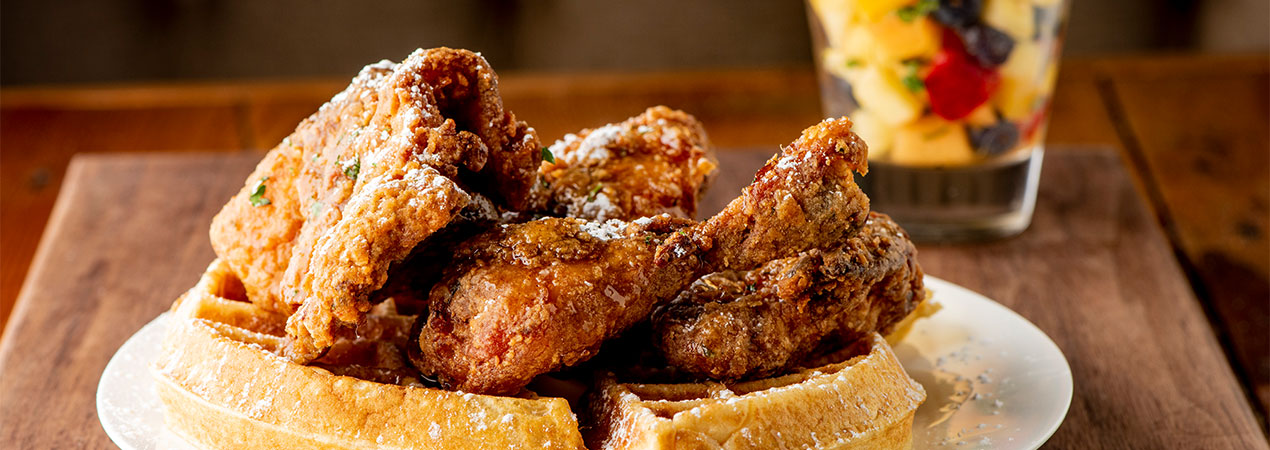
Downtown Orlando Satisfies Your Hunger For History
Turn up your downtown Orlando IQ with these experiences that blend a flavor of the past with your favorite tastes of today.

Parramore Heritage Neighborhood
A tour of the Parramore Heritage Neighborhood begins with a visit to the Wells’Built Museum of African American History, which became a local landmark in 1998. It was constructed in 1926 as a hotel that provided lodging to African Americans during segregation, including famous athletes and entertainers like Jackie Robinson, Ella Fitzgerald, and Ray Charles. The museum features memorabilia, artifacts, and a guest room with authentic furnishings of the 1930s. The building was added to the U.S. National Register of Historic Places in 2000.
Continue on South Street to see Dr. Wells’ house, which was built in 1924 and locally landmarked in 2003, and the Hankins Building at the corner of Parramore Avenue, a 1947 Art Deco commercial building constructed by another community leader, Dr. I.S. Hankins.
After your stroll, it’s just a 3-minute drive to Nikki’s Place where you can feast on southern and soul food classics like fried chicken, barbecue, greens, yams, and more.
From there, take a walk around the corner to Z. L. Riley Park. There’s a playground, open green spaces, and a collection of colorful mosaic artwork made by youth from the Parramore Kidz Zone that mixes African themes with Zellie Riley’s contributions to the community. Mr. Riley was a significant Parramore businessman and civil rights leader who played a key role in organizing the Negro Chamber of Commerce in the 1950s, now known as the African American Chamber of Commerce of Central Florida.
Central Business District
As the center of the settlement that became Orlando, downtown’s modern core is full of historic buildings and sites. Several of these are located on Church Street.
After the railroad arrived in 1880, businesses began relocating from their sites near the courthouse (roughly Court and Magnolia Avenues) to be near the train depot. For a time, Bumby Hardware served as the depot until the new building was completed in 1890. It still stands today alongside the SunRail station. Bumby Hardware was in business for 80 years until closing in 1966. Its building is now home to the Hamburger Mary’s, a great place to enjoy sandwiches, salads, gourmet burgers for lunch or dinner. There’s also a Broadway Brunch on Sundays with live entertainment.
After your meal, stroll along Gertrude’s Walk, named for Gertrude Sweet, once voted the prettiest woman of Orange County. Records don’t reveal why this path was named for Gertrude; perhaps it was a nice gesture from her brother, Charles Sweet, who served as Orlando’s sixth mayor in 1880.
Church Street is also home to the Kress building, with its decorative terra cotta and Art Deco styling. Opened in 1936, Kress was a department store that also operated a lunch counter for downtown’s businessmen and shoppers. Today, Kres Chophouse, located on the ground floor, serves a mix of creative and traditional selections for a historic dining experience.
Lake Eola Heights District
As a designated historic district by the National Register of Historic Places, Lake Eola Heights is one of downtown Orlando’s oldest and most architecturally diverse neighborhoods. Stroll along the shady, tree-lined streets and you’ll see a mix of Craftsman, Mediterranean Revival, Colonial Revival, and frame vernacular residences that blend with Art Deco and traditional homes.
South Eola District
Though predominantly residential, the South Eola district features downtown Orlando’s crown jewel, Lake Eola Park. Originally owned by Jacob Summerlin, the land was donated to the city and declared a public park in 1888. The sinkhole was fed by a natural aquifer from below and stormwater from above to form a beautiful lake with 4,500 feet of shoreline. You can enjoy lakeside views along with a range of upscale and casual fare like Relax Grill or World of Beer.
Lake Cherokee Historic District
Throughout the district’s long history which began in 1887, its namesake, Lake Cherokee, has enjoyed multiple monikers, from Lake Eva to Lake Minnie to its final name. Today, the district is home to many architectural styles resulting from the 1920s Florida land boom, including Craftsman-style bungalows, Mediterranean, Tudor, and Colonial Revivals.
There is ample free street parking throughout the neighborhood. Park on the east side of Lake Cherokee then walk counterclockwise around the lake to its west side where you’ll find the Poyntz-O’Neal House: home of newlyweds, John Poyntz and Minnie Hall, and built in 1887. The couple started a trend with a total of five newlywed couples eventually building homes on the lake, which inspired its “Honeymoon Row” nickname.
After admiring the lakeside homes, head west on Agnes Street then north on Delaney Avenue toward Lake Lucerne where you’ll discover one of the coolest “new” features of this century-old district: The Wellborn apartments (1947). Located adjacent to the Dr. Phillips house (1893), The Wellborn apartments were fashioned after the finest Art Deco designs of the 1940s. Today, these two historical places have been revived into one of the coolest new hidden gems in downtown: The Wellborn. Stop-in and have a drink on the patio, fresh bites in the guest house, or linger in history by staying in one of the apartments that have been converted into hotel rooms.